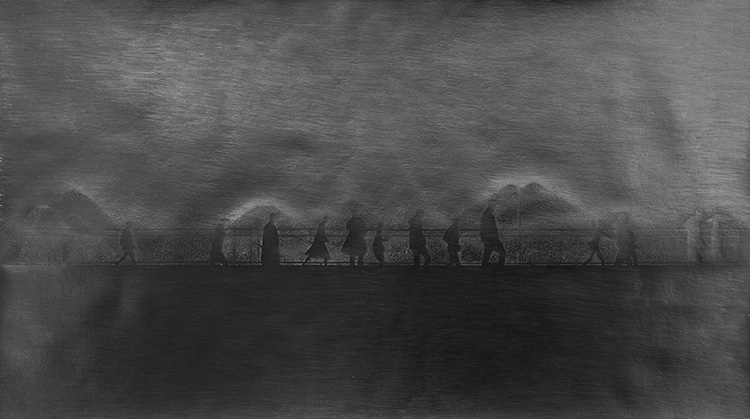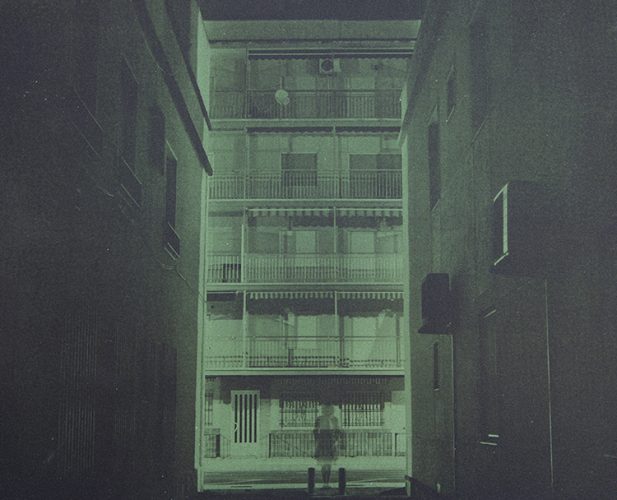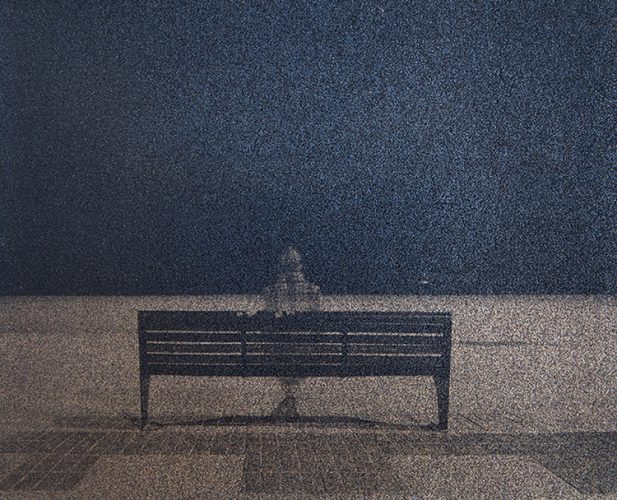Exposed
From April 12, Birgit Graschopf is presenting works from her current series at Galerie Haas & Gschwandtner in Salzburg. The opening will take place on Friday, April 12, starting at 18:00. The artist will be present present. A catalog accompanies the exhibition.
Birgit Graschopf, born 1978 in Vienna, graduated in photography at the University of Applied Arts in Vienna. In her current work, she combines the medium of photography with aspects of drawing, painting and the stylistic device of perforation, and with the presence of the body, she also explores and opens up new (public) spaces. Her works and wall exposures can be found among others. in the Albertina in Vienna and in numerous private and corporate collections. She performed a performative wall exposure in the Museum der Moderne Salzburg in 2018. Birgit presents her latest works on concrete, as the last extensive show in the Galerie Haas and Gschwandtner before the gallery moves into a new 330 square meter premises at Neutorstrasse in July.
The multi-designation of the exhibition title „Exposed“ is also intended to highlight various facets of the Birgit’s work. In a broader sense, it also means “being exposed”. Similarly, the figurative aspect should not be ignored. The word “Pose”, which can be found in the exhibition title, alludes to the factor of staging, an important work process in creating Graschopf.
Places and architecture. Wall, concrete and sandpaper
The artist will present a large-scale wall exposure at the gallery based on a photograph of Gino Valle’s residential complex in Udine’s outskirts. The architecture is similar to that of the gallery rooms. The dialogue between the two architectures, in Udine and Salzburg, is captured by the wall exposure. Consequently, the artist continues her engagement with the exhibition spaces. The precise positioning of the photograph on the wall to be exposed in the gallery creates an expanded space, plays with the perspective and directs the viewer’s gaze to the figure in the photograph. Birgit Graschopf’s wall exposures have a picturesque feel, by means of the liquids used and applied by hand to the surface to be exposed. Each wall exposure is handmade, the application is always different and determines how the photo is seen. Sometimes this is too light or too dark. On photo paper, the work would be redone. A wall exposure is unique, an individual photo is exposed on the damp wall. The technique is similar to that of frescoes. On closer examination, the character of the “photograffitis” as well as the imperfection like spatters, scratches. Graschopf perceives photography as a non-reproducible medium. The shape of the wall exposure bypasses the status of copyability, each implementation evolves differently and reveals a different version of the original photograph. It is not only the application of the chemicals and the emulsion behave differently each time. Graschopf’s works thus always have the character of a unique work of art.
Partly eerily fairytale-like pictorial spaces emerge in the stagings of the artist. She deliberately exposes them to unusual materials such as walls, concrete and sandpaper. She calls it herself as locations of time and space on extraordinary materials. “The interaction of image and material creates different moods, from mysterious to brutal,” says Graschopf. The cold, the weight, the porosity and the aesthetics of the concrete captivate the artist.
The photographs portray the exposure of a person in public space. And they create a doubling of the architecture, as it now appears as an image on the same material from which it was originally built. The material concrete as an image carrier is ideal, shown in the photo as well, it now becomes the mediator of the work, forms the body of the artwork.
It is the same with the material sandpaper. It glitters, has a velvety look and does not look the way it feels. It could be soft, but it still feels rough when it is felt. Its use for abrading and abrading surfaces, called abrasion, is a brutal process. The sandpaper, an abrasive material, is destroyed after use. For Graschopf it serves as the medium for the presentation of her imagery.
Perforations
The so-called perforations form an independent and continuous complex of works. Here, the artist coats the paper with a soft graphite pencil (monolithic pencil), she hatches the surface, which is alternately polished once or twice with a soft cloth. Three to four layers are created. This process is similar to the emulsion process of Graschopf’s wall exposures. Again, the surface of the artwork is covered with various chemicals. The painterly act is realized by drawing. Working on the perforations requires a lot of care and patience. On the back of the graphite-coated paper, she attaches her photos. With the mounted template on the back, she now begins to outdo the contours of the architecture, the figures and the environment. The piercing causes pits and small craters. The visualization of the invisible is also the basic concept of the work process. Through the perforation of the paper, through the small craters, the metallic shimmer of graphite paper, the picture develops a life of its own with different lighting and viewing angles. The reliefed image lets contours become visible, arches up.
In contrast to the common digitization, the artist is analogizing in her artistic photography, distancing herself from the smooth, clean surfaces of digital images on our screens, and choosing the realization on peculiar but always suitable materials. The result is a variety of photographs of residential complexes by Le Corbusier and Gino Valle and fascist architecture in the time of Benito Mussolini, whose socio-cultural concepts provide the background for surreal visual worlds that are partly reminiscent of De Chirico’s paintings, but which also seem mysterious and eerie.
Text by Martina Pohn


 Bleakish Appearances »
Bleakish Appearances »
 Concrete #7 »
Concrete #7 »
 Concrete #2 »
Concrete #2 »
 Untitled, from the series “The Nocturne of Alicante” »
Untitled, from the series “The Nocturne of Alicante” »
 Untitled #2, from the series “The Nocturne of Alicante” »
Untitled #2, from the series “The Nocturne of Alicante” »
 Untitled #3, from the series “The Nocturne of Alicante” »
Untitled #3, from the series “The Nocturne of Alicante” »
 Untitled #4, from the series “The Nocturne of Alicante” »
Untitled #4, from the series “The Nocturne of Alicante” »
 Untitled #5, from the series “The Nocturne of Alicante” »
Untitled #5, from the series “The Nocturne of Alicante” »
 Untitled #6, from the series “The Nocturne of Alicante” »
Untitled #6, from the series “The Nocturne of Alicante” »
 Untitled #7, from the series “The Nocturne of Alicante” »
Untitled #7, from the series “The Nocturne of Alicante” »
 Untitled #8, from the series “The Nocturne of Alicante” »
Untitled #8, from the series “The Nocturne of Alicante” »
 Untitled #9, from the series “The Nocturne of Alicante” »
Untitled #9, from the series “The Nocturne of Alicante” »
 Untitled #10, from the series “The Nocturne of Alicante” »
Untitled #10, from the series “The Nocturne of Alicante” »
 Untitled #11, from the series “The Nocturne of Alicante” »
Untitled #11, from the series “The Nocturne of Alicante” »
 Untitled #12, from the series “The Nocturne of Alicante” »
Untitled #12, from the series “The Nocturne of Alicante” »
 Installation view Exposed, Wall exposure, 2019 »
Installation view Exposed, Wall exposure, 2019 »
 Installation view Exposed, 2019, Perforations, works on concrete and abrasive paper »
Installation view Exposed, 2019, Perforations, works on concrete and abrasive paper »
 Installation view Exposed, 2019, Perforations »
Installation view Exposed, 2019, Perforations »
 Installation view Exposed, 2019, perforation and foto on concrete »
Installation view Exposed, 2019, perforation and foto on concrete »
 Installation view Exposed, 2019, Wall exposure, works on concrete and abrasive paper »
Installation view Exposed, 2019, Wall exposure, works on concrete and abrasive paper »